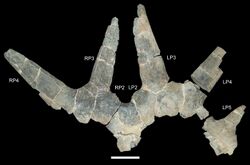Biology:Rubeosaurus
| Rubeosaurus | |
|---|---|

| |
| Holotype specimen | |
| Scientific classification | |
| Domain: | Eukaryota |
| Kingdom: | Animalia |
| Phylum: | Chordata |
| Clade: | Dinosauria |
| Clade: | †Ornithischia |
| Suborder: | †Ceratopsia |
| Family: | †Ceratopsidae |
| Subfamily: | †Centrosaurinae |
| Clade: | †Eucentrosaura |
| Tribe: | †Centrosaurini |
| Genus: | †Rubeosaurus McDonald & Horner, 2010 |
| Type species | |
| †Styracosaurus ovatus Gilmore, 1930
| |
| Species | |
| |
Rubeosaurus (meaning "bramble or thornbush lizard") is a genus of ceratopsian dinosaur which lived in what is now North America. Rubeosaurus fossils have been recovered from strata of the upper Two Medicine Formation of the Upper Cretaceous of Montana, dating to 74.6 million years ago.[1]
History of discovery
The holotype specimen, USNM 11869, is composed of a partial parietal and was discovered by George F. Sternberg in 1928. A second specimen, MOR 492, is composed of a partial skull including a partial left premaxilla, co-ossified left and right nasals with horncore, partial left postorbital with horncore, and a nearly complete right parietal with two spikes. It was discovered in 1986.[1]
This genus was named by Andrew T. McDonald and John R. Horner in 2010, and the type species is Rubeosaurus ovatus. Formerly this species was assigned to Styracosaurus.[2]. It is notable for its large broad–based nasal horn and the ornamentation of its bony frill: there were one or two pairs of straight spikes on the edge, with the two spikes closest to the midline pointing so that they converged.[1] Immature specimens referred to a separate genus, called Brachyceratops, may be juvenile Rubeosaurus.[1][3]
Juvenile specimen
In 2007, Michael J. Ryan and colleagues suggested that Brachyceratops was possibly the juvenile form of Rubeosaurus.[3] A 2011 study supported this idea for the most mature specimen of Brachyceratops, USNM 14765, which shows one unique newly evolved feature (apomorphy) in common with Rubeosaurus to the exclusion of other centrosaurines. However, the same study suggested that because the holotype specimen of Brachyceratops is too incomplete and juvenile to preserve any determinable apomorphies, Brachyceratops must be considered a nomen dubium, and cannot be a senior synonym of Rubeosaurus.[4]
Classification
The cladogram presented below follows a phylogenetic analysis including Rubeosarus by Chiba et al. (2017), who recovered it as the sister taxon of Styracosaurus:[5]
| Centrosaurinae |
| |||||||||||||||||||||||||||||||||||||||||||||||||||||||||||||||||||||||||||||||||||||||||||||||||||||||||||||||
Holmes et al. (in press) argued that the proposed diagnostic characters of Rubeosaurus ovatus fall within the range of asymmetry and intraspecific anatomical variation documented in Styracosaurus albertensis. The authors considered R. ovatus to be a junior synonym of Styracosaurus albertensis.[6]
See also
References
- ↑ 1.0 1.1 1.2 1.3 Andrew T. McDonald & John R. Horner, (2010). "New Material of "Styracosaurus" ovatus from the Two Medicine Formation of Montana". Pages 156–168 in: Michael J. Ryan, Brenda J. Chinnery-Allgeier, and David A. Eberth (eds), New Perspectives on Horned Dinosaurs: The Royal Tyrrell Museum Ceratopsian Symposium, Indiana University Press, Bloomington and Indianapolis, IN.
- ↑ Gilmore, Charles W. (1930). "On dinosaurian reptiles from the Two Medicine Formation of Montana". Proceedings of the United States National Museum 77 (16): 1–39. doi:10.5479/si.00963801.77-2839.1. https://www.biodiversitylibrary.org/page/32382634.
- ↑ 3.0 3.1 Ryan, Michael J.; Holmes, Robert; Russell, A.P. (2007). "A revision of the late Campanian centrosaurine ceratopsid genus Styracosaurus from the Western Interior of North America". Journal of Vertebrate Paleontology 27 (4): 944–962. doi:10.1671/0272-4634(2007)27[944:AROTLC2.0.CO;2]. http://www.bio.ucalgary.ca/contact/faculty/pdf/russell/314.pdf. Retrieved 2010-08-19.
- ↑ McDonald, A. T. (2011). Farke, Andrew Allen. ed. "A Subadult Specimen of Rubeosaurus ovatus (Dinosauria: Ceratopsidae), with Observations on Other Ceratopsids from the Two Medicine Formation". PLoS ONE 6 (8): e22710. doi:10.1371/journal.pone.0022710. PMID 21853043.
- ↑ Kentaro Chiba; Michael J. Ryan; Federico Fanti; Mark A. Loewen; David C. Evans (2018). "New material and systematic re-evaluation of Medusaceratops lokii (Dinosauria, Ceratopsidae) from the Judith River Formation (Campanian, Montana)". Journal of Paleontology in press. doi:10.1017/jpa.2017.62.
- ↑ Robert.B. Holmes; Walter Scott Persons; Baltej Singh Rupal; Ahmed Jawad Qureshi; Philip J. Currie (2019). "Morphological variation and asymmetrical development in the skull of Styracosaurus albertensis". Cretaceous Research in press: Article 104308. doi:10.1016/j.cretres.2019.104308.
Wikidata ☰ Q555915 entry



